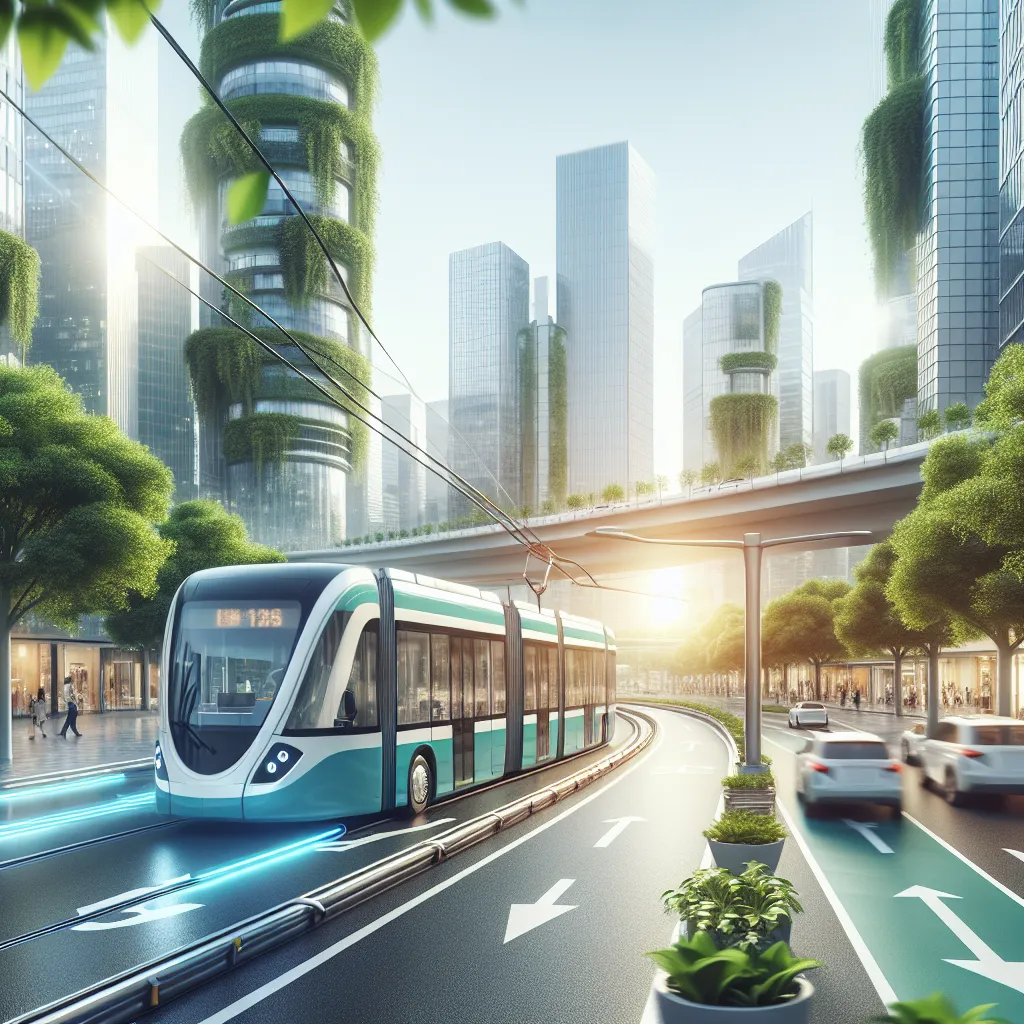Welcome to our IELTS Reading practice test focusing on the impact of electric public transportation on pollution. This test simulates the real IELTS exam, providing you with an opportunity to enhance your reading skills and expand your knowledge on this crucial environmental topic.
 Electric buses in urban setting
Electric buses in urban setting
Introduction
The transition to electric public transportation is a key strategy in combating urban pollution and climate change. This IELTS Reading practice test explores various aspects of this shift, including its environmental benefits, challenges, and future prospects. By engaging with this material, you’ll not only prepare for your IELTS exam but also gain valuable insights into a pressing global issue.
IELTS Reading Test
Passage 1 – Easy Text
The Rise of Electric Public Transportation
Electric public transportation is rapidly gaining traction in cities worldwide as a solution to combat air pollution and reduce carbon emissions. Unlike traditional diesel-powered buses and trains, electric vehicles (EVs) produce zero direct emissions, significantly improving air quality in urban areas. This shift is particularly crucial in densely populated cities where air pollution poses severe health risks to residents.
The adoption of electric buses, trams, and trains offers multiple benefits. Firstly, they contribute to a substantial reduction in greenhouse gas emissions, helping cities meet their climate goals. Secondly, electric public transportation vehicles are generally quieter than their fossil fuel counterparts, reducing noise pollution in urban environments. This improvement in acoustic ecology can have positive effects on residents’ quality of life and even property values in areas previously affected by traffic noise.
Moreover, the operational costs of electric public transportation can be lower in the long run. While the initial investment in electric vehicles and charging infrastructure may be higher, the reduced maintenance requirements and lower fuel costs can lead to significant savings over time. This economic advantage is particularly appealing to city planners and transit authorities working with limited budgets.
However, the transition to electric public transportation is not without challenges. The most significant hurdle is the upfront cost of replacing existing fleets with electric vehicles and installing the necessary charging infrastructure. Additionally, concerns about battery life, range anxiety, and the need for frequent charging stops can complicate route planning and scheduling.
Despite these challenges, many cities are making ambitious commitments to electrify their public transportation systems. For example, Amsterdam aims to have all public buses and boats emission-free by 2025, while Los Angeles plans to convert its entire bus fleet to electric by 2030. These initiatives are often supported by national and international policies promoting clean energy and sustainable urban development.
As technology advances and economies of scale reduce costs, the adoption of electric public transportation is expected to accelerate. This shift not only addresses immediate air quality concerns but also paves the way for more sustainable and livable cities in the future.
Questions 1-5
Do the following statements agree with the information given in the reading passage?
Write:
TRUE if the statement agrees with the information
FALSE if the statement contradicts the information
NOT GIVEN if there is no information on this
- Electric vehicles produce no direct emissions during operation.
- The adoption of electric public transportation can lead to a decrease in noise pollution.
- All cities worldwide have committed to fully electric public transportation by 2030.
- The maintenance costs for electric vehicles are generally lower than for diesel vehicles.
- Battery technology is no longer a concern for electric public transportation.
Questions 6-10
Complete the sentences below.
Choose NO MORE THAN TWO WORDS from the passage for each answer.
- Electric public transportation helps cities meet their __ __.
- The __ __ of electric vehicles is often higher than traditional vehicles.
- Amsterdam plans to have all public buses and boats __ __ by 2025.
- Los Angeles aims to convert its entire __ __ to electric by 2030.
- The adoption of electric public transportation is expected to __ as technology improves and costs decrease.
Passage 2 – Medium Text
Environmental and Economic Impacts of Electric Public Transportation
The transition to electric public transportation represents a paradigm shift in urban mobility, offering a potent solution to the pressing issues of air pollution and climate change. As cities worldwide grapple with the detrimental effects of vehicular emissions on public health and the environment, the electrification of buses, trams, and trains emerges as a beacon of hope. This shift not only promises cleaner air and reduced carbon footprints but also heralds a new era of sustainable urban development.
At the heart of the environmental benefits lies the dramatic reduction in local air pollutants. Traditional diesel-powered public transportation vehicles are significant contributors to urban air pollution, emitting particulate matter, nitrogen oxides, and other harmful substances. Electric vehicles, in contrast, produce zero tailpipe emissions, leading to immediate and tangible improvements in air quality. A study conducted in Shenzhen, China, which has fully electrified its bus fleet, reported a reduction of 432,000 tons of carbon dioxide emissions annually, equivalent to taking 93,000 passenger cars off the road for a year.
The ripple effects of improved air quality extend beyond environmental metrics to public health outcomes. Research has consistently shown a correlation between exposure to air pollution and increased incidence of respiratory diseases, cardiovascular problems, and even premature deaths. By reducing these harmful emissions, electric public transportation can contribute to significant public health benefits, potentially saving billions in healthcare costs and improving the overall quality of life for urban residents.
From an economic perspective, the transition to electric public transportation presents a complex picture of short-term investments and long-term savings. The initial capital expenditure for electric vehicles and associated charging infrastructure is substantial, often requiring significant public funding or innovative financing models. However, the operational cost savings over the lifecycle of electric vehicles can be considerable. Electric buses, for instance, have been shown to have 30% lower total cost of ownership compared to diesel buses over a 12-year period, primarily due to lower fuel and maintenance costs.
Moreover, the electrification of public transportation can stimulate local economies by creating new jobs in manufacturing, installation, and maintenance of electric vehicles and charging infrastructure. It also positions cities at the forefront of green technology adoption, potentially attracting investment and talent in clean energy and sustainable transportation sectors.
However, the transition is not without challenges. The intermittent nature of renewable energy sources, which are often touted as the ideal power source for electric vehicles, necessitates robust energy storage solutions and smart grid management. There’s also the question of the environmental impact of battery production and disposal, which requires careful consideration and sustainable practices throughout the supply chain.
As cities continue to invest in electric public transportation, the benefits are becoming increasingly evident. Beyond the immediate environmental and health impacts, this shift is reshaping urban landscapes, influencing city planning, and changing the way people interact with public spaces. The reduced noise pollution from electric vehicles contributes to more livable urban environments, potentially increasing property values and enhancing the quality of life in previously traffic-heavy areas.
In conclusion, while the path to fully electric public transportation is fraught with challenges, the potential rewards in terms of environmental sustainability, public health, and long-term economic benefits make it a compelling direction for urban development. As technology advances and costs continue to decrease, the electrification of public transportation is poised to play a pivotal role in creating cleaner, healthier, and more sustainable cities for future generations.
Questions 11-14
Choose the correct letter, A, B, C, or D.
-
According to the passage, which of the following is NOT mentioned as a benefit of electric public transportation?
A) Reduction in carbon dioxide emissions
B) Improvement in air quality
C) Increase in urban green spaces
D) Decrease in noise pollution -
The study conducted in Shenzhen, China, found that the electrification of their bus fleet resulted in:
A) A reduction of 93,000 tons of carbon dioxide emissions
B) The equivalent of removing 432,000 cars from the road
C) A reduction of 432,000 tons of carbon dioxide emissions
D) The equivalent of removing 93,000 cars from the road for a year -
The passage suggests that the total cost of ownership for electric buses over a 12-year period is:
A) 30% higher than diesel buses
B) 30% lower than diesel buses
C) Equal to diesel buses
D) Not mentioned in the passage -
Which of the following is presented as a challenge in the transition to electric public transportation?
A) Lack of public interest
B) Insufficient battery capacity
C) The intermittent nature of renewable energy sources
D) Decreased job opportunities
Questions 15-20
Complete the summary below.
Choose NO MORE THAN TWO WORDS from the passage for each answer.
The transition to electric public transportation offers significant environmental and economic benefits. It leads to a reduction in (15) __ __, improving air quality and public health. While the (16) __ __ for electric vehicles is high, there are considerable (17) __ __ over time. The change can also stimulate local economies by creating jobs in various sectors. However, challenges include the need for (18) __ __ solutions and sustainable practices in battery production. Despite these obstacles, electric public transportation is reshaping urban landscapes and contributing to more (19) __ __ environments. As technology advances and costs decrease, it is expected to play a crucial role in creating (20) __, healthier cities for the future.
Passage 3 – Hard Text
The Transformative Potential of Electric Public Transportation Systems
The paradigm shift towards electric public transportation systems represents a multifaceted approach to addressing the intricate challenges of urban mobility, environmental sustainability, and public health. As cities worldwide grapple with the exigencies of climate change and the deleterious effects of air pollution, the electrification of public transit emerges as a promising solution, albeit one fraught with complexities and nuanced implications.
The environmental benefits of transitioning to electric public transportation are manifold and significant. The most immediate and tangible impact is the dramatic reduction in local air pollutants, including particulate matter, nitrogen oxides, and sulfur dioxide. These pollutants, ubiquitous in urban environments dominated by internal combustion engines, are primary contributors to respiratory diseases, cardiovascular problems, and premature mortality. A comprehensive study conducted by the European Environment Agency estimated that exposure to fine particulate matter (PM2.5) alone resulted in approximately 307,000 premature deaths in the EU in 2019. The widespread adoption of electric buses, trams, and trains could substantially mitigate these health risks, leading to improved quality of life and reduced healthcare expenditures.
Moreover, the shift to electric public transportation aligns with global efforts to reduce greenhouse gas emissions and combat climate change. While the carbon footprint of electric vehicles (EVs) is dependent on the electricity generation mix, even in regions heavily reliant on fossil fuels for electricity production, EVs typically result in lower lifecycle emissions compared to their internal combustion counterparts. As countries progressively transition to renewable energy sources, the environmental benefits of electric public transportation will be further amplified, creating a synergistic effect in the fight against climate change.
The economic implications of this transition are multifaceted and extend beyond the immediate realm of public transportation. While the initial capital expenditure for electric vehicles and associated charging infrastructure is substantial, the long-term operational cost savings can be significant. A study by Bloomberg New Energy Finance projected that electric buses would reach upfront cost parity with diesel buses by 2030, and their total cost of ownership is already lower in many cases due to reduced fuel and maintenance expenses. Furthermore, the electrification of public transportation can catalyze job creation in emerging sectors such as battery technology, charging infrastructure, and smart grid management, potentially offsetting job losses in traditional automotive and fossil fuel industries.
However, the transition to electric public transportation is not without its challenges and potential drawbacks. One of the primary concerns is the environmental impact of battery production and disposal. The extraction of raw materials for batteries, particularly lithium and cobalt, raises ethical and environmental concerns, including habitat destruction, water pollution, and human rights issues in mining communities. Additionally, the end-of-life management of electric vehicle batteries presents a significant challenge, necessitating the development of efficient recycling processes and circular economy approaches to minimize waste and recover valuable materials.
Another critical consideration is the strain on electrical grids that widespread adoption of electric public transportation could impose. As cities electrify their bus fleets and expand electric rail systems, the increased demand for electricity, particularly during peak charging times, could necessitate substantial upgrades to power distribution infrastructure. This challenge is compounded by the intermittent nature of renewable energy sources, requiring sophisticated energy storage solutions and smart grid management systems to ensure reliable and efficient operation of electric public transportation networks.
The social and urban planning implications of this transition are equally profound. The reduced noise pollution from electric vehicles could transform urban soundscapes, potentially increasing property values in previously traffic-heavy areas and improving overall quality of life. However, this shift may also exacerbate existing socioeconomic disparities if the benefits of improved air quality and quieter streets are not equitably distributed across urban areas.
In conclusion, the transition to electric public transportation represents a complex and multifaceted endeavor with far-reaching implications for environmental sustainability, public health, economic development, and urban planning. While the challenges are significant, the potential benefits in terms of reduced emissions, improved air quality, and long-term cost savings make it an essential component of sustainable urban development strategies. As technology continues to advance and economies of scale drive down costs, the electrification of public transportation is poised to play a pivotal role in shaping the future of urban mobility and contributing to more livable, sustainable cities.
Questions 21-26
Complete the summary below.
Choose NO MORE THAN THREE WORDS from the passage for each answer.
The transition to electric public transportation offers significant environmental benefits, including a reduction in (21) __ __ __. A study by the European Environment Agency found that exposure to fine particulate matter led to approximately (22) __ __ __ in the EU in 2019. While the environmental impact of electric vehicles depends on the (23) __ __ __, they generally result in lower lifecycle emissions compared to traditional vehicles. Economically, although the (24) __ __ __ for electric vehicles is high, long-term operational costs are often lower. However, challenges include the environmental impact of (25) __ __ __ and the potential (26) __ __ __ caused by increased electricity demand.
Questions 27-32
Do the following statements agree with the claims of the writer in the reading passage?
Write:
YES if the statement agrees with the claims of the writer
NO if the statement contradicts the claims of the writer
NOT GIVEN if it is impossible to say what the writer thinks about this
- Electric public transportation will completely eliminate air pollution in urban areas.
- The adoption of electric vehicles in public transportation can lead to job creation in new sectors.
- The extraction of raw materials for batteries has no negative environmental impacts.
- Electric buses are expected to reach upfront cost parity with diesel buses by 2030.
- The transition to electric public transportation will solve all urban mobility challenges.
- Reduced noise pollution from electric vehicles could increase property values in some areas.
Questions 33-36
Choose the correct letter, A, B, C, or D.
-
According to the passage, which of the following is NOT mentioned as a challenge in transitioning to electric public transportation?
A) Environmental impact of battery production
B) Strain on electrical grids
C) Increased traffic congestion
D) End-of-life management of batteries -
The passage suggests that the benefits of electric public transportation may:
A) Be equally distributed across all urban areas
B) Exacerbate existing socioeconomic disparities
C) Only affect wealthy neighborhoods
D) Have no impact on property values -
Which of the following best describes the author’s stance on the transition to electric public transportation?
A) Enthusiastically supportive without reservations
B) Cautiously optimistic, acknowledging both benefits and challenges
C) Neutral, presenting only facts without opinion
D) Skeptical, focusing primarily on the drawbacks -
Based on the passage, the future of urban mobility is likely to be:
A) Dominated entirely by personal electric vehicles
B) Unchanged from current transportation systems
C) Shaped significantly by electric public transportation
D) Focused on reverting to non-motorized transport options
Answer Key
Passage 1
- TRUE
- TRUE
- FALSE
- TRUE
- NOT GIVEN
- climate goals
- upfront cost
- emission-free
- bus fleet
- accelerate
Passage 2
- C
- C
- B
- C
- local air pollutants
- initial capital expenditure
- operational cost savings
- energy storage
- livable urban
- cleaner
Passage 3
- local air pollutants
- 307,000 premature deaths
- electricity generation mix
- initial capital expenditure
- battery production and disposal
- strain on electrical grids
- NO
- YES
- NO
- YES
- NOT GIVEN
- YES
- C
- B
- B
- C
Conclusion
This IELTS Reading practice test on the impact of electric public transportation on pollution provides a comprehensive overview of the topic while challenging your reading comprehension skills. By engaging with complex texts and diverse question types, you’ve not only prepared for the IELTS exam but also gained valuable insights into a crucial environmental issue.
For more practice on related topics, you might find these articles helpful:
- [The Benefits and Challenges of Electric Vehicles](https://www.ielts.net/the-benefits


